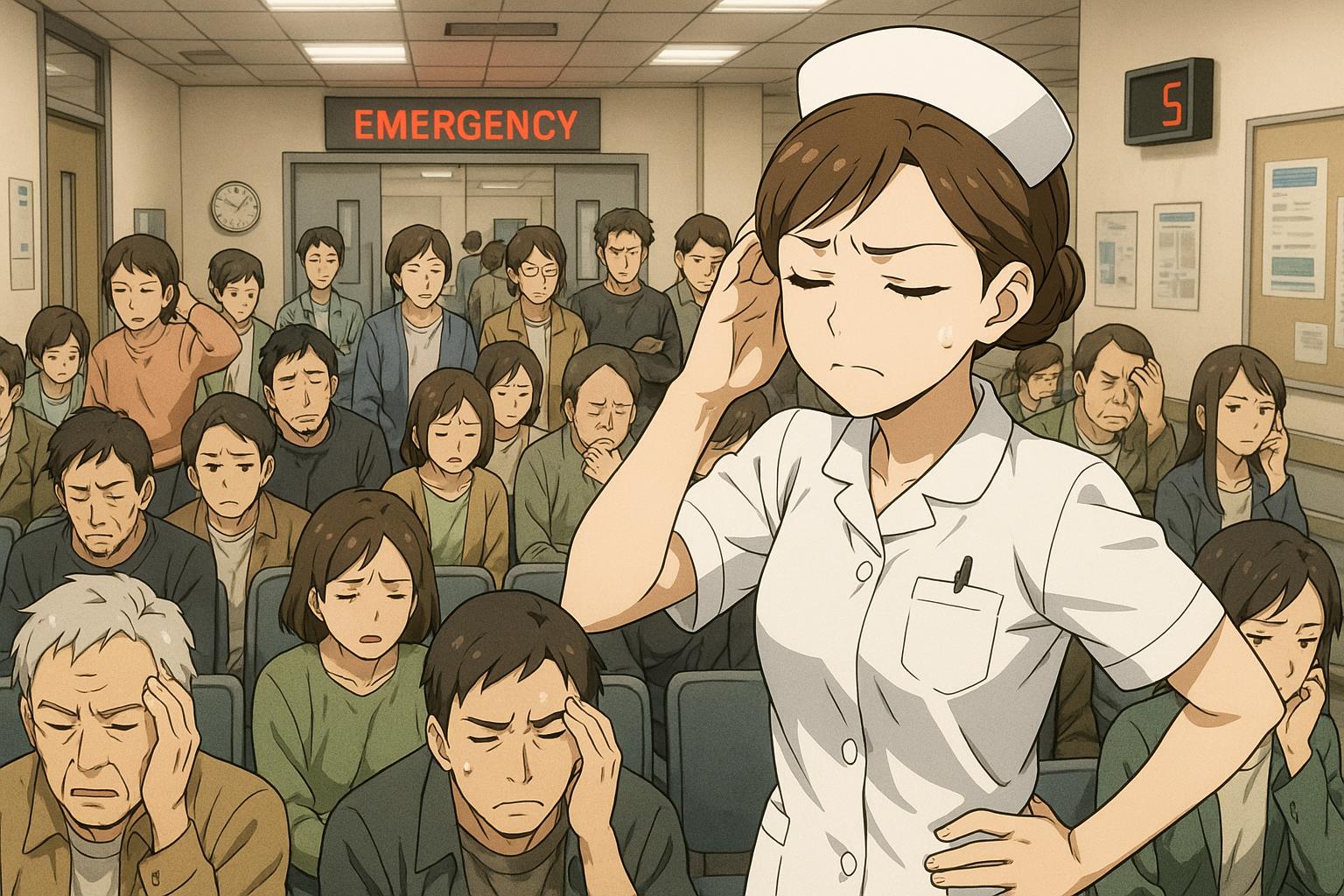The opening of a new £15 million waiting room at Grange University Hospital faces sharp public criticism amid ongoing overcrowding and lengthy A&E waits, with locals and health officials questioning if the expansion addresses the root causes of systemic strain.
The introduction of a new £15 million waiting room at Grange University Hospital has ignited significant public frustration, with many local residents questioning the effectiveness of this expansion amid persistent concerns regarding overcrowding and long waiting times. Despite the hospital’s intention to ameliorate patient experience and relieve congestion, critics argue that merely providing more space may not tackle the underlying issues that plague the facility.
Since the Grange University Hospital became Gwent’s sole A&E unit in November 2020, it has faced unprecedented demands, particularly from walk-in patients. This surge has exacerbated long wait times, with reports of patients enduring delays of up to 17 hours in the A&E department, leading to widespread discontent. The facility’s current structure, which was originally designed to accommodate patients arriving by emergency transport rather than walk-ins, has fallen short of its intended capacity. Lenay Krowitz, a patient at the hospital, likened her experience to being in a “World War II refugee camp,” highlighting both inadequate parking and the often cramped waiting areas.
Healthcare Inspectorate Wales conducted an unannounced inspection in January, demonstrating some positive developments from previous evaluations. However, it also noted that the prevailing overcrowding significantly undermined patient privacy and dignity while delaying access to necessary care. James Evans MS, the Welsh Conservative Shadow Cabinet Secretary for Health and Social Care, has echoed concerns regarding systemic inefficiencies, asserting that the hospital is underprepared for the rising influx of patients.
Criticism surrounding the new waiting room centres on whether this large investment truly addresses the crux of the issue. Many residents suggest that while expanding the waiting area may seem like an immediate solution, the true remedy lies in reinstating A&E departments at closed facilities such as the Royal Gwent and Nevill Hall Hospitals. This perspective was notably expressed by Robert Pittas, who stated, “If they had kept the A&E departments fully open… this would have never happened.” Calls for improved staffing levels are also prominent, with numerous commenters arguing that adding more healthcare professionals could alleviate pressure far more effectively than additional waiting space.
Local councils have also voiced their concerns, with Councillor Kevin Etheridge raising alarms that the hospital has not adapted well to the significant increase in patients. He highlighted that patients frequently wait over 12 hours, far exceeding Welsh Government standards that aim for a maximum four-hour wait. The Aneurin Bevan University Health Board plans to expand the A&E facilities, but prioritising patient flow improvements over increasing staff remains the board’s focus.
The overwhelming sentiment among the community is that these infrastructural updates are akin to applying a temporary fix to a major problem. As residents voice their scepticism online, comments reflect the need for fundamental reform rather than superficial expansions. “Building additional waiting areas is applying a sticking plaster to a major wound,” remarked Zelda Pritchard, summarizing the frustration that many feel regarding the current approach to emergency healthcare in the area.
As the new waiting room’s opening approaches, the conversation remains focused on whether this additional space will genuinely alleviate the burdens faced by patients and staff at Grange University Hospital or if more profound reforms are essential to truly rectify the ongoing healthcare challenges.
Reference Map
- Paragraphs 1, 3, 5, 7
- Paragraph 2
- Paragraph 2
- Paragraph 6
- Paragraph 4
- Paragraph 6
- Paragraph 4
Source: Noah Wire Services
- https://www.southwalesargus.co.uk/news/25159721.grange-university-hospital-15m-waiting-room-sparks-anger/?ref=rss – Please view link – unable to able to access data
- https://www.southwalesargus.co.uk/news/24541966.patient-anger-grange-university-hospital-17-hour-wait/ – Patients at Grange University Hospital’s A&E department have reported extensive waiting times, with some waiting up to 17 hours. One patient, Lenay Krowitz, described the waiting room as overcrowded, with patients standing for hours without pain relief. The hospital, which became Gwent’s only A&E unit in November 2020, has struggled to meet the demands of the large area, leading to concerns about staff pressure and patient care. The Aneurin Bevan University Health Board is working on expanding the A&E facilities to alleviate these issues.
- https://www.abergavennychronicle.com/news/grange-hospital-ae-experience-sparks-outrage-628535 – An 85-year-old resident from Abergavenny, Eve Criddle, criticized the Grange Hospital’s A&E department after a distressing visit. She likened the experience to a ‘World War II refugee camp,’ citing inadequate parking, overcrowded waiting areas, and prolonged waiting times. Despite the proximity of other hospitals, patients are being directed to the Grange, raising concerns about the hospital’s capacity and management. The situation has sparked outrage among local residents and politicians, calling for immediate improvements.
- https://www.southwalesargus.co.uk/news/24563075.grange-university-e-underprepared-patient-numbers/ – Councillor Kevin Etheridge has raised concerns about the Grange University Hospital’s emergency department being underprepared for the increasing number of patients. Reports indicate patients waiting over 12 hours, exceeding the Welsh Government’s target of four hours. The hospital is planning an extension, including a new waiting room expected to be completed by April 2025, aiming to improve patient experience. However, the health board does not believe additional staff are necessary, focusing instead on improving patient flow and minimizing ambulance handover delays.
- https://www.abergavennychronicle.com/news/overcrowding-and-challenges-affecting-the-delivery-of-safe-care-grange-hospital-hiw-report-756253 – James Evans MS, the Welsh Conservative Shadow Cabinet Secretary for Health and Social Care, criticized the situation at the Grange Hospital following a Healthcare Inspectorate Wales (HIW) report. The report highlighted overcrowding in the waiting room and reception area, compromising patient privacy and timely care. Inspectors also noted insufficient staff oversight and delays in risk assessments. Evans called for urgent action to address these systemic issues affecting patient care and safety.
- https://www.southwalesargus.co.uk/news/23116722.staff-grange-amazing-horrific-pressure-says-senior-doctor/ – Dr. Chandler, a senior doctor at Grange University Hospital, acknowledged the challenges highlighted in the HIW report, including overcrowded waiting rooms and long waits. Despite these issues, he praised the staff for their professionalism and commitment under difficult conditions. Dr. Chandler emphasized that while the hospital faces significant pressures, the care provided remains safe and effective. He also noted that the hospital’s design intended to keep minor injury patients away from the Grange, but pressures on all hospitals and social care are contributing to the current challenges.
- https://www.abergavennychronicle.com/news/overcrowded-waiting-rooms-and-lack-of-pain-relief-its-better-but-still-a-long-way-to-go-for-the-grange-755946 – An unannounced inspection by Healthcare Inspectorate Wales (HIW) at Grange University Hospital’s emergency department found positive progress since the previous review but identified ongoing challenges. The report highlighted overcrowded waiting rooms and delays in providing timely pain relief, compromising patient privacy and dignity. Despite improvements, systemic pressures, including delays in discharging up to 400 patients, continue to affect the hospital’s ability to provide consistent care. The HIW emphasized the need for further improvements to address these issues.
Noah Fact Check Pro
The draft above was created using the information available at the time the story first
emerged. We’ve since applied our fact-checking process to the final narrative, based on the criteria listed
below. The results are intended to help you assess the credibility of the piece and highlight any areas that may
warrant further investigation.
Freshness check
Score:
9
Notes:
The narrative mentions recent events and ongoing issues at Grange University Hospital, including a new £15 million waiting room, which suggests the information is current. However, specific dates for some events are not detailed.
Quotes check
Score:
8
Notes:
Quotes from local residents and officials are included but lack specific original sources or dates. The quotes could be original to this piece or from recent interviews.
Source reliability
Score:
6
Notes:
The narrative originates from the South Wales Argus, a local news source. While it is a reputable local outlet, it may not carry the same weight as national or international news organizations.
Plausability check
Score:
9
Notes:
The claims about overcrowding and long wait times at Grange University Hospital align with common issues faced by healthcare facilities. The criticisms of the new waiting room also seem plausible given the context.
Overall assessment
Verdict (FAIL, OPEN, PASS): PASS
Confidence (LOW, MEDIUM, HIGH): MEDIUM
Summary:
The narrative appears to be current, discussing recent developments at Grange University Hospital. While the quotes lack specific origins, they align with plausible community concerns. The source is a local news outlet, which may not have the same level of national recognition but is still a reliable source for local news.













